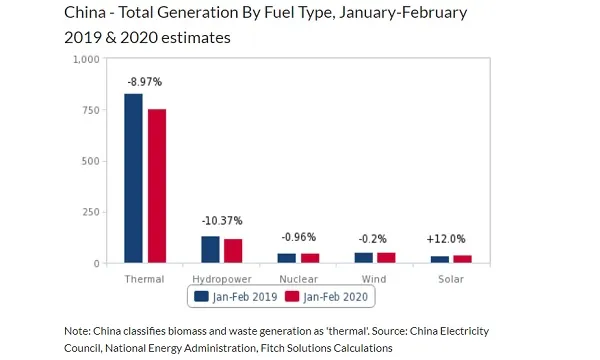
China's solar power to remain resilient despite power demand shock
Lower emissions following the lockdown may have helped increase solar output.
Solar generation is expected to remain resilient in 2020 despite the overall demand shock for power generation by extension, according to a Fitch Solutions report.
According to data from China’s National Energy Administration (NEA), power generation in January and February contracted YoY across all fuel sources, except for solar power which jumped 12%. Fitch attributed this largely to its grid access priority, amidst the ongoing drive by the government to reduce curtailment rates across the renewables sector.
Furthermore, the lockdown in China has reduced the overall industrial emissions in the country, which may have helped increase the capacity factor of solar due to reduced smog that blocks out the sunlight.
The sector has also been receiving government support. In particular, a $212m (RMB1.5b) subsidy budget has been set aside for solar, of which $140.85m (RMB1bn) will be allocated for large-scale PV projects and $70.42m (RMB500m) for distributed solar.
Although lower than in 2019, China was already initially due to phase out subsidies for solar in 2020, which meant that the phase-out policy is being delayed, which could provide some near-term relief for the sector.
Furthermore, there has been a backlog of projects in 2019 that could support capacity growth in 2020 and 2021. The solar capacity growth slowed in 2019 due to the relatively late release of the solar expansion policy and the resulting late approval of projects.
China is projected to add about 30GW of solar capacity in 2020, and nearly 300GW in total over the coming decade.
Renewable energy is also expected to register continued cost deflation in the Chinese market, making the sector more attractive on a cost-basis relative to conventional sources of power generation.
“In times of recent global economic uncertainty, this will be particularly important given that solar generation requires near-zero marginal costs, reducing the need to import thermal fuels,” the report noted.
China’s power consumption is tipped to grow 3% in 2020 amidst the COVID-19 pandemic. Whilst Fitch expects strong fiscal stimulus from the government, it will likely be more measured and targeted as Beijing remains wary of its high debt load.













 Advertise
Advertise











